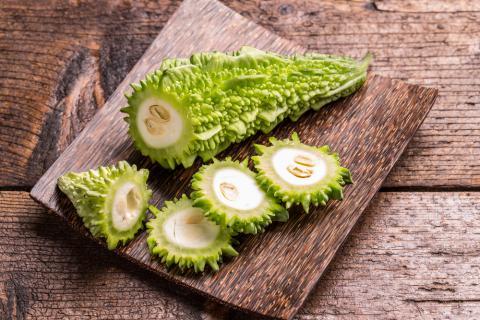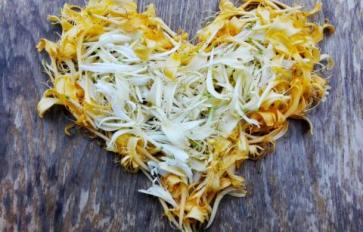
Bitter melon is a member of the family Cucurbitaceae or the Cucumber family of the genus Citrullus Schrad, also known as watermelon P, and contains two species. The plant is native to India and regions of Africa and through trade it was introduced to areas of Asia like China and Japan. It then made its way to the Philippine Islands and regions of northern and eastern Europe. The entire fruit is used: the flesh is an ingredient in recipes; the seeds are used for healing purposes; and the leaves are made into tea. It is considered a healing food as it is rich in nutrients. Its name describes its flavor and it has many names: in India it is called karavella; it is known in the Philippines as ampalaya or parya; and in Japan they call it nigauri or tsurureishi. In English it is known as African cucumber, bitter gourd, and balsam pear.
Bitter melon is a vining plant with leaves that are deeply lobed and are much like squash leaves. The plant produces vines that can be thirteen to sixteen feet in length. The fruit is oblong in shape, much like a pointed cucumber with skin that can be smooth or bumpy with warts, and grows to approximately from two to ten inches in length. The color of the bitter melon changes from green to yellow and ripens to orange. The flesh has a crunchy texture and has a high water content. It has a bitter flavor that is an acquired taste.
One note of warning: Because it has abortifacient properties, it is advised that pregnant women avoid ingesting the plant. The seeds are also extremely toxic to children.
Health Benefits of Bitter Melon
Bitter melon is rich in nutrients that include vitamins A, C, E, B1, B2, and B3, and also folate. It is high in the following minerals: potassium, calcium, zinc, magnesium, phosphorus, and iron. It is also a good source of dietary fiber. One of its most unusual benefits is that it reacts in the body much as insulin.
Bitter melon is very effective in inhibiting viruses. Because of its high vitamin C content, it is used as an antiviral herb, preventing diseases like measles and various strains of pox. In the tropics it is used to prevent malaria. It is also effective in the treatment of HIV and the leaves reduce the risk of contracting herpes simplex type 1 virus.
There are many other health benefits provided by bitter melon; these are only a few examples. The seeds are used to reduce the risk of developing breast cancer, cervical cancer, and prostate cancer without side effects. The leaves and fruit are made into an infusion to treat fevers and dysentery. It may also be significant in the prevention of diabetes; studies indicate that bitter melon can regulate blood sugar and has been used historically as a hypoglycemic agent.
Growing Bitter Melon
Bitter melon is a sub-tropical and tropical plant and makes a nice addition to the garden in mild climates. Because it is a vine it needs support, like a trellis, and does well in good draining sandy or loam silt soil. It likes full sunlight and the soil should be prepared with aged manure and aged compost. Plant two seeds one-half inch deep and spaced about twelve inches apart. The seeds will germinate in eight to ten days. Use a six foot square trellis and prune the shoots to encourage vertical growth. Water regularly and add compost periodically during the growing season. In colder climates bitter melon does well in containers. Use at least a five gallon pot but a larger container would be better and it should drain well.








